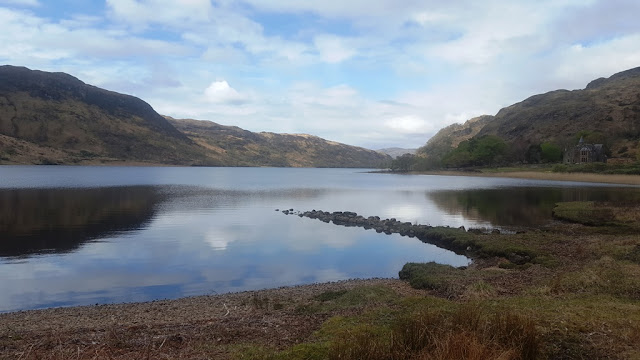Iona - North End
Had a little bit of time today while down in Iona doing some other work, and as the weather was good it seemed a good opportunity to go out and have a look at the north end of Iona for a change. I havent spent as much time in this part of the island as I have in the south so it felt like a good chance to do some familiarisation.
Last time I was at the north end was last year, with Brian Upton for a quick rake around and to talk rocks! No esteemed company today unfortunately!
The sea views are great:
Looking north
Stac Mhic Mhurchaidh in the distance there, behind Eilean Chalbha. SMM is a columnar dolerite, probably of Palaeogene age, Eilean Chalbha like most of Iona is Lewisian so much older
What I really wanted to look at was the "basal conglomerate at the base of the "Iona Group" rocks. The Iona Group used to be described as Torridonian but modern research tends to suggest the term "of Torridonian affinity" as they are not quite like the classic Torridonian rocks of the North West. Still quite enigmatic and not totally understood
Some pics of the conglomerate:
Ruler for scale showing clasts most of which appear to be of gneiss
Near the base and the contact with the Lewisian, some of the clasts are quite large. I should have had the 2014 paper by McAteer et al (Sedimentary provenance, age and possible correlation of the Iona Group
SW Scotland) as it contains a lot of info on these rocks.Anyway, can come back another time and look at it in detail
The Iona Group rocks dip steeply and look almost like slate:
The beach at the north of Iona is one of the best anywhere - superb views over to Mull and to the north
Beautiful white shell sand
Here is a video showing the view:
There are all sorts of interesting boulders on the shore, many of which are Ross of Mull Granite. Also some garnet amphibolite - the sort of rock that is common at Ardalanish and Uisken
Garnet amphibolite
Some of the Ross of Mull Granite is quite coarse - looks like the RM2 type - the stuff that has large K-feldspar phenocrysts:
Ross of Mull Granite boulder
Running E-W approximately, there is one of those Camptonite dykes, marked on the BGS map, as "Lc". This one has eroded out to produce a long sinuous ravine:
It really is an obvious feature, intruded into both the Iona Group rocks and the Lewisian. BGS map suggests that these are of Permian age. Lots of these in Iona esp on the east side - most of them seem to erode out rather than stand up like a wall. The dyke rock is clearly visible in various places in the bottom of the channel
Finally it was time to leave - just a couple of shots to show how clear the water looked:

Last picture taken from the ferry
Last time I was at the north end was last year, with Brian Upton for a quick rake around and to talk rocks! No esteemed company today unfortunately!
The sea views are great:
Looking north
Stac Mhic Mhurchaidh in the distance there, behind Eilean Chalbha. SMM is a columnar dolerite, probably of Palaeogene age, Eilean Chalbha like most of Iona is Lewisian so much older
What I really wanted to look at was the "basal conglomerate at the base of the "Iona Group" rocks. The Iona Group used to be described as Torridonian but modern research tends to suggest the term "of Torridonian affinity" as they are not quite like the classic Torridonian rocks of the North West. Still quite enigmatic and not totally understood
Some pics of the conglomerate:
Ruler for scale showing clasts most of which appear to be of gneiss
Near the base and the contact with the Lewisian, some of the clasts are quite large. I should have had the 2014 paper by McAteer et al (Sedimentary provenance, age and possible correlation of the Iona Group
SW Scotland) as it contains a lot of info on these rocks.Anyway, can come back another time and look at it in detail
The Iona Group rocks dip steeply and look almost like slate:
The beach at the north of Iona is one of the best anywhere - superb views over to Mull and to the north
Beautiful white shell sand
Here is a video showing the view:
There are all sorts of interesting boulders on the shore, many of which are Ross of Mull Granite. Also some garnet amphibolite - the sort of rock that is common at Ardalanish and Uisken
Garnet amphibolite
Some of the Ross of Mull Granite is quite coarse - looks like the RM2 type - the stuff that has large K-feldspar phenocrysts:
Ross of Mull Granite boulder
Running E-W approximately, there is one of those Camptonite dykes, marked on the BGS map, as "Lc". This one has eroded out to produce a long sinuous ravine:
It really is an obvious feature, intruded into both the Iona Group rocks and the Lewisian. BGS map suggests that these are of Permian age. Lots of these in Iona esp on the east side - most of them seem to erode out rather than stand up like a wall. The dyke rock is clearly visible in various places in the bottom of the channel
Finally it was time to leave - just a couple of shots to show how clear the water looked:

Last picture taken from the ferry
















Comments